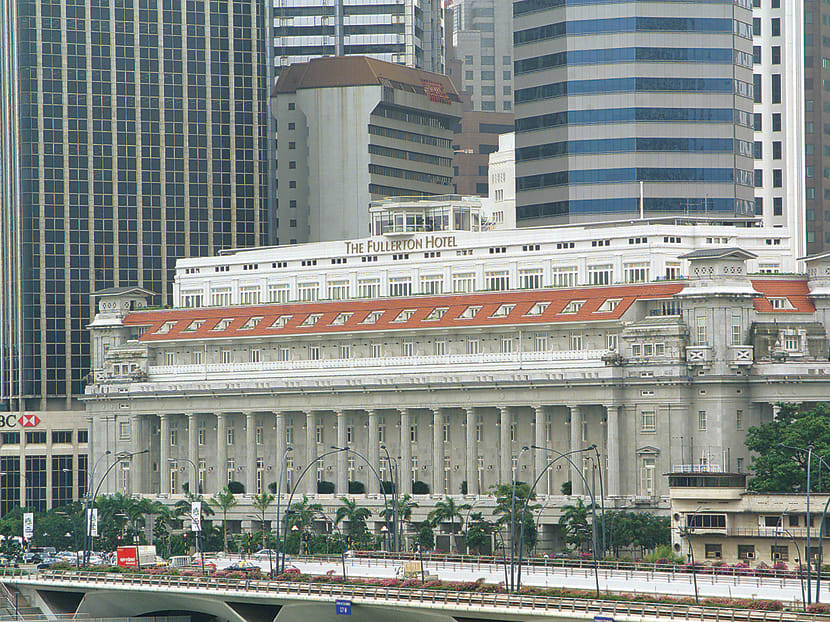Fullerton building: From GPO to national landmark
SINGAPORE — Overlooking the mouth of the Singapore River and the heart of the Central Business District, the Fullerton Hotel’s colossal two-storey Doric colonnade bore witness, for almost nine decades, to the growth of the country through the colonial and pre-independence era till today.

The former Fullerton Building, now The Fullerton Hotel, has been gazetted as Singapore's 71st national monument. Photo: Jason Quah/TODAY
SINGAPORE — Overlooking the mouth of the Singapore River and the heart of the Central Business District, the Fullerton Hotel’s colossal two-storey Doric colonnade bore witness, for almost nine decades, to the growth of the country through the colonial and pre-independence era till today.
Before its present day incarnation as a five-star hotel, the building was home to the former General Post Office, and over different periods of time, housed government offices and departments where some of the Republic’s pioneer leaders began their careers, as well as a hospital providing makeshift operation rooms for wounded British soldiers during World War II.
Today (Dec 7), the iconic eight-storey building — which was declared open on June 27, 1928 — was given its own place in history when it was gazetted as Singapore’s 71st National Monument.
The gazetting ceremony was attended by Prime Minister Lee Hsien Loong, as well as Culture, Community and Youth Minister Grace Fu and Emeritus Senior Minister Goh Chok Tong, who had worked at the building in his days with the Economic Planning Unit in the 1960s.
PM Lee himself had fond memories of the building. During General Elections, political parties would hold lunchtime rallies at Fullerton Square and his father, Mr Lee Kuan Yew, who was Singapore’s founding Prime Minister, delivered “many stirring and memorable speeches” there, as his mother listened from the balcony of the building, he said.
“When I first entered politics in 1984, I too spoke at the Fullerton Square rally, which back then was still at Fullerton Square,” PM Lee said. “Today we still call it the ‘Fullerton Rally’, but it’s actually at the UOB Plaza promenade at Boat Quay.”
Tracing the history of the building, which started out as the General Post Office, PM Lee noted that it was an important point of reference for public roads in Singapore.
Back then, the British used the milestone system for measuring road distances and the post office was “Mile Zero”. During the Japanese Occupation, the building became the headquarters of the Japanese Military Administration. Throughout the years, the building was home to many government offices.
“The transformation of this building reminds us of how far Singapore has come together as a nation. In its lifetime, we have developed from Third World to First,” PM Lee said.
He added: “When the Governor Sir Hugh Clifford opened this building in 1928, he said that ‘the building is, and will be for many years, one of the principal landmarks of Singapore’.
“Almost 90 years later, his words remain true. I am sure this building will continue to stand proud and handsome, and witness an even more prosperous and vibrant Singapore for many years to come.”
Under the Preservation of Monuments Act, gazetted buildings are preserved with the highest form of recognition for its national significance. Each National Monument has its own tailored set of preservation guidelines.
Made of reinforced concrete, the facade of Fullerton Hotel encompasses ornate classical decorations that were created by Swiss sculptor Rudolf Wening and Italian sculptor Cavaliere Rudolf Nolli, who was also responsible for the sculptural works at the former Supreme Court and the College of Medicine building.
Former marine officer Capt P J Thomas, 73, said that he holds many memories of the former Fullerton Building. He said: “However, the one that still remains vivid in my mind is standing on the balcony outside my office, looking at the clock on Victoria Memorial Hall, enjoying the cool breeze and adjusting my watch.”
At the time of its completion, the building represented Singapore’s status as the prime postal unit in British Malaya — there were 14 lifts in the building and the post office had automated mail-sorting equipment.
Mr M Bala Subramanion, 90, former Postmaster General, remembered how there was a tunnel from the building into the sea for postal boats to deliver and collect mail.
“The tunnel, measuring about 10ft high and 8ft broad, was large enough to enable assistant postmen to push trolleys carrying the postal bags,” he said.
From tomorrow until the end of February, a free exhibition on the building’s history and transformation will be held at the Fullerton Hotel’s East Garden Foyer Gallery.






